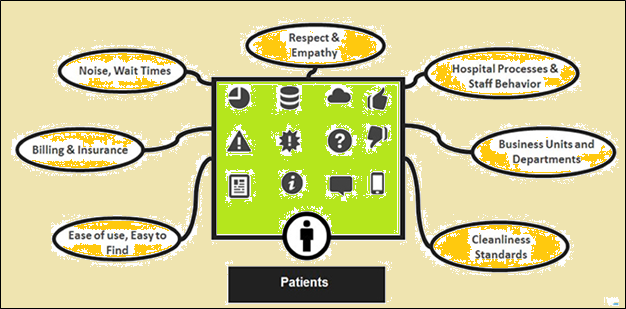Big data is being increasingly applied to improve patient experience and outcome globally. ປະສົບການຂອງຄົນເຈັບແລະຜົນໄດ້ຮັບໄດ້ຖືກລະເລີຍສ່ວນໃຫຍ່ແມ່ນມາເຖິງຕອນນັ້ນຕົ້ນຕໍແມ່ນຍ້ອນໂຮງຫມໍເຊື່ອກັນວ່າວ່າມັນຈໍາເປັນເພື່ອເຊື່ອມຕໍ່ unemotionally ແລະຈຸດປະສົງທີ່ມີຜູ້ປ່ວຍແລະປິ່ນປົວພະຍາດພະຍາດ. ແຕ່ວ່າໂຮງຫມໍໄດ້ຖືກຮັບຮູ້ວ່າການປິ່ນປົວຄົນເຈັບນອກເຫນືອໄປຈາກໂລກພະຍາດທາງດ້ານຮ່າງກາຍ. ມັນແມ່ນກ່ຽວກັບວິທີການຄົນເຈັບອາລົມຄວາມຮູ້ສຶກກ່ຽວກັບຫຼາຍສິ່ງຫຼາຍຢ່າງເຊັ່ນ: ເປັນການປະພຶດ, ການສະແດງອອກ facial, ມາໄດ້ສະດວກ, ຄວາມສະອາດ, ປະສົບການການເອີ້ນເກັບເງິນແລະການເອົາໃຈໃສ່ປະສົບການໃນໂຮງຫມໍ. ປັດໄຈດັ່ງກ່າວປະກອບປະສົບການຄົນເຈັບແລະໂຮງຫມໍແມ່ນຄວາມພະຍາຍາມເພື່ອສັງລວມການປະສົບການຄົນເຈັບໃນຮູບແບບຂອງຂໍ້ມູນຂະຫນາດໃຫຍ່ໄດ້. Several use cases testify to the effectiveness of big data in improving patient experience and outcome.
What does patient experience and outcome mean?
A patient’s experience with a hospital is not only connected to the quality of pure medical treatment but also with the overall emotional experience that includes, but may not be limited to ease of appointments, approachability and friendliness of staff, timeliness, empathy and cleanliness. Patients can award scores based on his or her overall emotional experience with the hospital. Big data technology is able to capture the emotional experience in the form of data. The image below shows that the broad range of emotions and experiences a patient can have is captured in the form of data in various mediums such as social media sites.
ຂໍ້ມູນກ່ຽວກັບປະສົບການຂອງຄົນເຈັບສາມາດໄດ້ຮັບມາຈາກແຫຼ່ງທີ່ແຕກຕ່າງກັນ, ສະແດງໃຫ້ເຫັນຢູ່ໃນຮູບພາບຂ້າງລຸ່ມນີ້.
ດັ່ງລຸ່ມນີ້ແມ່ນຫ້າວິທີທີ່ມີປະສິດທິຂໍ້ມູນຂະຫນາດໃຫຍ່ນີ້ຈະຖືກນໍາໃຊ້ເພື່ອປັບປຸງປະສົບການຂອງຄົນເຈັບແລະຜົນໄດ້ຮັບ.
ວິທີການ Cleveland Clinic
The Cleveland Clinic ຢ່າງຫຼວງຫຼາຍປັບປຸງປະສົບການຄົນເຈັບຂອງຕົນທີ່ມີການຊ່ວຍເຫຼືອຂອງການວິເຄາະໄດ້. ກັບຄືນໄປບ່ອນໃນ 2009, ຫ້ອງການຊ່ວຍເຫຼືອທີ່ບໍ່ໄດ້ຮັບການໄດ້ຮັບຄະແນນສູງສຸດຂອງດັດຊະນີຄວາມພຶງພໍໃຈຂອງຄົນເຈັບ. ບໍ່ຈໍາເປັນຕ້ອງລະບຸ, ທີ່ມີຢ່າງຫຼາຍຂອງການສົ່ງຜົນສະທ້ອນເປັນ. So, ຊີອີໂອ Dr. Cosgrove ຕັດສິນໃຈໃນການປັບປຸງການບໍລິການຄົນເຈັບຢ່າງຫລາຍໂດຍອາໄສການກ່ຽວກັບການວິເຄາະ. ເພື່ອເຮັດໃຫ້ວິໄສທັດເປັນຄວາມເປັນຈິງແລ້ວ, ຫ້ອງການຊ່ວຍເຫຼືອການຈ້າງ Dr. James Merlino ເປັນຫົວຫນ້າເຈົ້າຫນ້າຕໍາແຫນ່ງ. Dr. Merlino ຈ້າງເປັນອົງການພາກສ່ວນທີສາມມີການສຶກສາດ້ານປະລິມານແລະຄຸນນະພາບກ່ຽວກັບສິ່ງທີ່ຄົນເຈັບທີ່ຄາດວ່າຈະຈາກຫ້ອງການ. The findings from the analytics were different from what the clinic thought the patients expected from the clinic. The patients, the analytics revealed, expected respect, clear and consistent communication and happy hospital staff. These expectations were connected with the emotional state of the patients. Patients wanted display of concern and empathy from hospital staff. It is significant that the study by the outside firm could quantitatively capture patients’ feelings and deliver them as analytics.
Gaining insights from big data
Gaining insights is the first important step towards improving patient experience and there are a lot of ways to do that. First of all, data needs to be accessed from the different sources, as shown in the images above. After that, the data can be analyzed to find out patient feelings towards hospitals. For example, social media and website discussions could reveal that patients tend to feel a lot of anger at the billing inefficiencies of a particular hospital. Advanced analytics could quantify these ranges of emotions. Analytics engines could search websites such as Twitter to find out trending topics on healthcare and analyze the content. It is important to identify the most important issues in the minds of the patients — it could be availability of parking spaces, lack of clarity in communication, unclean bathrooms and even chaotic billing counters.
Identify trending or hot topics
The idea is to identify the trending topics and assign ratings to them to signify the seriousness or importance. For example, ຄໍາຄຶດຄໍາເຫັນໃນທາງບວກສາມາດໄດ້ຮັບການມອບສີຂຽວແລະຄໍາຄຶດຄໍາເຫັນໃນທາງລົບສາມາດໄດ້ຮັບສີແດງ. ການວິເຄາະທີ່ທັນສະໄຫມມີຄວາມສາມາດໃນການຜະລິດການຈັດອັນດັບຄວາມຫນ້າເຊື່ອຖືຈາກຂໍ້ສະເຫນີແນະດັ່ງກ່າວ. ຂໍ້ສະເຫນີແນະດັ່ງກ່າວຍັງສາມາດສະຫນອງອຸປະກອນທີ່ມີຄຸນຄ່າສໍາລັບໂຮງຫມໍທີ່ຈະສ້າງຕົວຊີ້ວັດການປະຕິບັດທີ່ສໍາຄັນ (KPI). ປະໂຫຍດດ້ວຍວິທີການຂອງການເກັບກໍາແລະວິເຄາະຂໍ້ມູນການນີ້ແມ່ນວ່າມັນຈະເກີດຫຍັງຂຶ້ນຂ້ອນຂ້າງໄວ, ເມື່ອປຽບທຽບກັບວິທີການພື້ນເມືອງຂອງການສໍາຫຼວດ.
ການສ້າງແຜນການດໍາເນີນການແລະເປົ້າຫມາຍ
ຫຼັງຈາກກໍານົດແນວໂນ້ມຫລືຮ້ອນຫົວຂໍ້, ຂັ້ນຕອນຕໍ່ໄປແມ່ນການກໍານົດທີ່ກໍານົດໄວ້ຂອງການປ່ຽນແປງທີ່ມີພາລະບົດບາດໃນຄວາມບໍ່ພໍໃຈຂອງຄົນເຈັບເປັນ. ການປ່ຽນແປງທີ່ກໍານົດໄວ້ຂອງຕົວກໍານົດການທີ່ມີຄຸນຄ່າໄດ້ຮັບມອບຫມາຍທີ່ແນ່ນອນ, ການປ່ຽນແປງໃນໄລຍະທີ່ໃຊ້ເວລາ. ໃນສະພາບການນີ້, ຕົວຢ່າງຂອງການປ່ຽນແປງທີ່ສາມາດຈະຜິດພາດການເອີ້ນເກັບເງິນ, ລໍຖ້າເວລາທີ່ພະແນກສືບສວນ, ຂາດຂອງຂະບວນການ, poor attitudes towards patients and difficulty in taking appointments. After the variables are identified, the hospital can decide on what constitutes an acceptable change in variable values. For example, the hospital could target to limit billing errors to 1% of the total number of bills generated in a month. Data science is also capable of reasonably estimating the impact of the change in variable values on patient experience.
Reducing readmissions
According to Paul Muller, Chief Software Evangelist at HP, hospital admissions in the United States constitute about 30% of the total annual healthcare cost and 20% of all hospital admissions happen within 30 days of discharge. Muller observed, “In other words, we’re potentially letting people go without having completely resolved their issues. Better utilizing big-data technology can have a very real impact, ສໍາລັບຕົວຢ່າງ, on the healthcare outcomes of your loved ones.” Obviously, reducing hospital readmissions could significantly improve patient outcome. But how could big data potentially help reduce readmissions? The key lies in accessing and analyzing medical and health data of the patients and developing plans accordingly. If a patient is readmitted within 30 days, something has most probably gone wrong with the post-discharge care. So, accurate analysis needs to be done on the possible risks, actions, emergency situations, medications, history of illnesses and so on.
Reducing avoidable expenses
According to Muller, medical errors are one of the biggest contributors to the avoidable medical expenses in the United States which could be as high as 17.6% of the GDP. Medical errors such as a sponge left in the stomach after operation or an overdose leading to infection could drive up the cost hospitals incur and the insurance expenses. Inefficiencies in the process also indirectly contribute to higher costs. This goes without saying that inefficiencies and errors can contribute substantially to patient dissatisfaction and reduce patient outcome scores. Big data analytics, combined with the right technology, can expose the problems in an objective manner. Deaths due to errors and negligence can drive patients away from a hospital. Right analysis can control the churn.
Summary
Patient experience and outcome have been neglected components of treatment for a long time and it is finally getting the attention it deserves. Big data most probably is the best way to address the issue. However, hospitals also need to consider the perspective of too much reliance on data. Statistics, at its best, can tell only a part of the story. The challenge is to getting its act together, by putting the action plan generated from the data in practice. There is another perspective also: can the investment in big data analytics also drive up hospital bills? That can be another area of patient experience. It will be interesting to see how hospitals play the balancing act.

